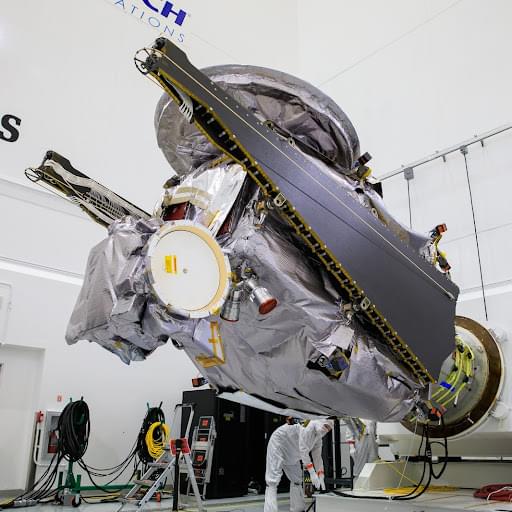NASA, along with the European Space Agency, is developing a campaign to return the Martian samples to Earth.



NASA is getting ready to launch a new science spacecraft Saturday (Oct. 16) to study asteroids near Jupiter, and you can watch mission coverage live all week.
Lucy — which will study Trojan asteroids, or asteroids that share the orbit of the giant planet — will fly to space from Cape Canaveral Space Force Station in Florida aboard a United Launch Alliance Atlas V rocket. With blast-off targeting 5:34 a.m. EDT (0934 GMT), live launch coverage will begin at 5 a.m. EDT (0900 GMT) on NASA Television, the NASA app, NASA social media channels and here at Space.com.

When the Nobel Prize-winning US physicist Robert Hofstadter and his team fired highly energetic electrons at a small vial of hydrogen at the Stanford Linear Accelerator Center in 1,956 they opened the door to a new era of physics.
Until then, it was thought that protons and neutrons, which make up an atom’s nucleus, were the most fundamental particles in nature.
They were considered to be ‘dots’ in space, lacking physical dimensions. Now it suddenly became clear that these particles were not fundamental at all, and had a size and complex internal structure as well.

India is entering the space industry.
India is opening doors for private companies to enter space.
PM Narendra Modi launched the Indian Space Association that will serve as a “single-window” for matters of space technology.
What is India’s game plan to win the global space race?
Palki Sharma tells you.
#India #PMModi #IndianSpaceAssociation.
About Channel:
WION-The World is One News, examines global issues with in-depth analysis. We provide much more than the news of the day. Our aim to empower people to explore their world. With our Global headquarters in New Delhi, we bring you news on the hour, by the hour. We deliver information that is not biased. We are journalists who are neutral to the core and non-partisan when it comes to the politics of the world. People are tired of biased reportage and we stand for a globalised united world. So for us the World is truly One.

Astronomers have confirmed the existence of a gigantic comet — and they say it’s headed towards Earth.
The comet was discovered by University of Pennsylvania astronomers Pedro Bernadinelli and Gary Bernstein, according to The Daily Beast. The pair initially found evidence of a 60 to 100 mile wide comet seven years ago and have finally released a paper confirming it late last month in the journal The Astrophysical Journal Letters.
Dubbed the Bernardinelli-Bernstein (BB) comet, the astronomers also described it as the “nearly spherical cow of comets” in the paper.

The historic mission is still going strong.
A Chinese lander and rover are still up and running more than 1,000 Earth days after they made a historic first-ever landing on the far side of the moon.
The Chang’e 4 lander carrying the Yutu 2 rover touched down in Von Kármán Crater on Jan. 2 2019, and the robotic mission has been exploring the unique area of our celestial neighbor ever since.

NASA’s next asteroid-bound mission to explore the earliest days of our solar system is nearly ready to launch.
The Lucy spacecraft is targeting a launch window that opens on Saturday (Oct. 16). After blastoff, the spacecraft will make a 12-year journey to the outer solar system, where it will visit half a dozen ancient “Trojan” asteroids that orbit in the same path as the planet Jupiter.
Not all who wander are lost – but sometimes their cell phone reception is. That might change soon if a plan to project basic cell phone coverage to all parts of the globe comes to fruition. Lynk has already proven it can use a typical smartphone to bound a standard SMS text message off a low-earth-orbiting satellite, and they don’t plan to stop there.
Formerly known as Ubiquitilink, Lynk was founded a few years ago by Nanoracks founder Charles Miller and his partners but came out of “stealth mode” as a start-up in 2019. In 2020 they then used a satellite to send an SMS message from a typical smartphone, without requiring the fancy GPS locators and antennas needed by other, specially made satellite phones.
The company continued its success recently by demonstrating a “two-way” link this week using a newly launched satellite, its fifth, called “Shannon.” They’ve also proved it over multiple phones in numerous areas, including the UK, America, and the Bahamas.

Jupiter, Saturn, Uranus, or Neptune may have sent the Earth-sized planet barreling toward deep space.
Scientists believe that there could be a ninth planet in our solar system, lurking somewhere beyond Neptune—but don’t get too excited, because this isn’t about Pluto.
Rather, this is the story of a mysterious Earth-or Mars-sized planet that may have swirled beyond the asteroid belt, among the gas giants, before they ultimately swept this potential “Planet 9” toward the outer reaches of our solar system… or even into deep space. The theory makes sense on its face: Jupiter is kind of known as a bully, after all.